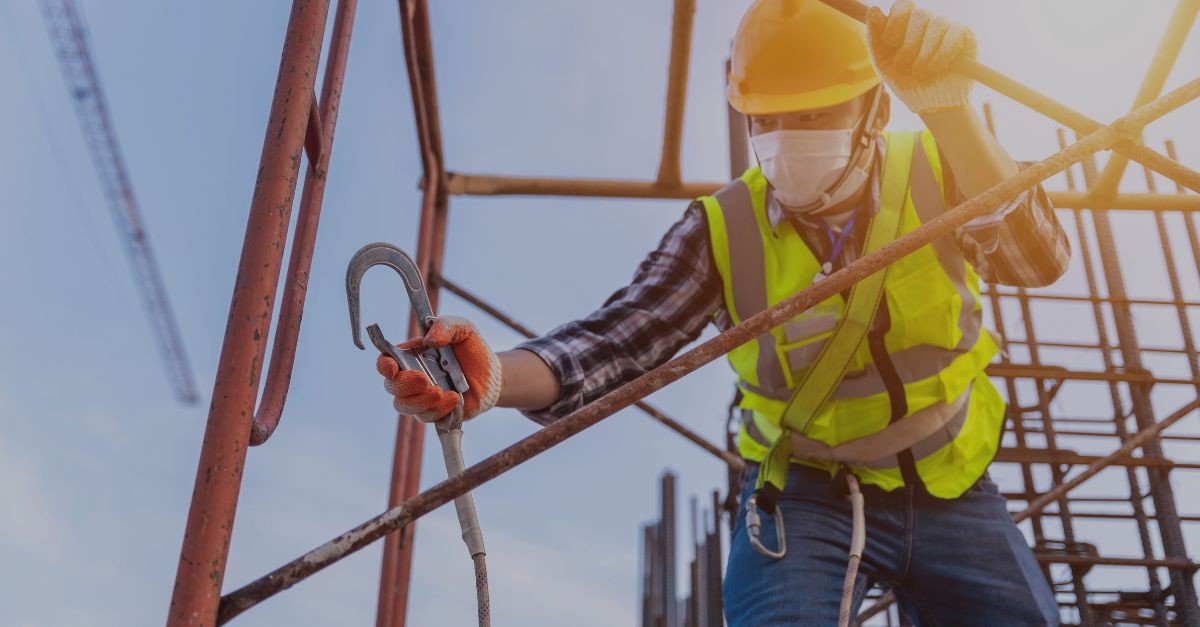In the bustling world of heavy industry, safety isn't just a buzzword – it's the longstanding key to success. One of the most significant hazards workers face, particularly when operating at heights, is the risk of falls. The potential for severe injury or even fatality is a stark reality within these environments, making fall protection systems not just a critical component of operations but a moral obligation for employers.
Whether it's the construction of imposing skyscrapers, maintenance within towering power plants, or the meticulous work on offshore rigs, comprehensive fall protection is the thread that weaves through successful, secure, and sustainable industrial practices. Here, we explore the multifaceted realm of fall protection, offering insights into why it's indispensable in heavy industrial operations.
The Gravity of Workplace Falls
Statistics reveal a sobering truth – falls are among the most prevalent workplace accidents in heavy industrial settings, with catastrophic outcomes affecting both individuals and the greater company. According to OSHA, around 700 construction workers perished from work-related falls in 2022, while nonfatal falls with days away from work numbered over 46,000 the same year.
The financial burden of these incidents is equally staggering, with fall-related costs such as workers’ compensation and medical costs estimated to exceed $70 billion annually in the United States alone. When it comes to the heavy industrial sector, these numbers are not only reflective of a significant loss in human capital, but also in terms of production delays, legal ramifications, and reputational damage for businesses.
Preventing falls translates to significant cost savings for companies, not only through reduced worker's compensation claims and insurance premiums but also via increased productivity and employee morale.
The financial argument in favor of comprehensive fall protection is bolstered by research showing a substantial return on investment. A study by The Center for Construction Research and Training found that a dollar invested in fall protection yields a $35 cost savings for a company.
The Regulatory Safety Net
To combat the alarming toll of fall-related injuries and fatalities, the Occupational Safety and Health Administration (OSHA) has laid down stringent guidelines for employers. These regulations mandate the implementation of robust fall protection systems, training for employees, and diligent inspection of equipment.
Companies operating within heavy industry must comply with a myriad of OSHA standards, including those for general industry, construction, and maritime. From guardrail requirements to personal fall arrest systems and safety net standards, the onus is on employers to provide a secure environment that minimizes the risk of falls.
A Deep Dive into Active vs. Passive Fall Protection Systems
The distinction between active and passive fall protection systems forms the bedrock of workplace safety in environments where the risk of falls is eminent. Active fall protection in heavy industry necessitates the engagement and awareness of the user, involving equipment such as body harnesses, connectors, and anchors which demand regular inspection and maintenance to ensure their integrity. On the other hand, passive fall protection provides a safeguard without necessitating interaction from the workforce, through the implementation of safety nets, guardrails, and barricades, acting as a steadfast barrier against fall hazards.
This delineation underpins a broader categorization of fall protection methods, encompassing fall elimination, prevention, arrest, and restraint, each with a pivotal role in mitigating the risk of falls. With fall elimination aiming to remove the hazard altogether, and fall prevention focused on forestalling falls through both active and passive means, the intent is always clear—safeguarding the workforce at every possible juncture.
Conversely, fall arrest and restraint systems, inherently active in nature, offer a critical safety net, ensuring that even in the event of a fall, the consequences are significantly mitigated. Within the construction industry, the application of these systems—including fall arrest, positioning, retrieval, and suspension systems—highlight the sector's multifaceted approach to ensuring worker safety amidst the myriad risks posed by working at height.
The ABCs of Fall Protection Systems
When it comes to safeguarding against falls, heavy industry has at its disposal a range of systems, each tailored to specific environmental and operational constraints. Personal fall arrest systems, commonly consisting of a full body harness, lanyard, and anchor points, are integral for workers who require mobility at heights.
For environments where engineered guards are appropriate, systems such as guardrails, handrails, safety nets, and warning lines form a passive yet robust defense against falls. Incorporating these into the design and daily work practices can significantly reduce the likelihood of accidents.
Ladder Fall Protection: Ensuring Safety Through Innovation
Ladders, a fundamental tool for reaching various heights, have been instrumental throughout human history. Their significance can be traced back to a Mesolithic rock painting over 10,000 years old, located in the Spider Caves in Valencia, Spain, showcasing humans using a ladder to harvest honey from a wild bee nest. This depiction not only highlights the ladder's long-standing utility but its evolution into a critical component of work at elevation, especially within the construction industry. OSHA defines a ladder as a device with rungs, steps, or cleats used for ascending or descending between different elevations. A "fixed ladder" is further specified as one that is permanently attached to structures, buildings, or equipment, distinguishing it from temporary or portable ladder solutions.
Given the inherent risks associated with ladder use, particularly fixed ladders, ladder fall protection has become an essential focus for safety regulations and innovations. A pivotal regulation milestone is the requirement that, on and after November 18, 2036, all fixed ladders on above ground storage tanks must be equipped with either a personal fall arrest system or a ladder safety system. This mandate underscores the commitment to enhancing worker safety through the adoption of advanced protective measures. Two primary ladder safety systems have been developed to comply with this directive:
- Cable Systems: These comprise a cable assembly anchored at the ladder's top and include intermediate brackets for cable support, plus a tension-applied cable bracket at the bottom. A cable "traveler" attaches to the user's harness and glides along the cable, locking in place if a fall occurs. Cable systems are economical for ladders over 50 feet tall and are versatile for use on structures like monopoles and lattice towers.
- Rigid Track Systems: These feature a track assembly anchored along the ladder's length, with a track "carriage" that users attach to their harness. The carriage moves along the track and locks in case of a fall. Track systems distribute forces evenly along the ladder, making them suitable for ladders with lower strength and in environments with high wind speeds due to their reduced susceptibility to vibration.
Furthermore, Personal Fall Arrest Systems (PFAS) utilizing a davit system attached to the ladder's top rungs offer another layer of safety. The system includes a self-retracting lifeline (SRL) that connects to the user's harness and locks in the event of a fall. These systems, often favored for their user-friendly design and attachment to the universally existing back dorsal D-Ring on OSHA-compliant harnesses, also provide users with a grab bar at the ladder's top for added stability.
The evolution of ladder safety, from its earliest depictions to today's highly regulated and technologically advanced systems, demonstrates a continuous commitment to safeguarding those who work at heights. With years of experience in the ladder fall protection arena, CATSI understands that the development and enforcement of such safety systems are not just about compliance with regulations, but about protecting lives and ensuring peace of mind for workers across various industries. By integrating the latest in safety technology and upholding stringent safety standards, CATSI continues to demonstrate its dedication to mitigating risks and elevating safety protocols for clients worldwide. This focus on continuous improvement and commitment to safety excellence underscores why CATSI stands as a leader in the ladder fall protection field.
Real World Resilience
In the real world, the efficacy of fall protection systems is not a theoretical proposition – it’s a lived reality that professionals witness and experience each day. Case studies from heavy industry showcase how meticulous planning, regular equipment checks, and swift response protocols can avert disaster.
From the deployment of remote monitoring for at-risk zones to the swift implementation of emergency drills, proactive measures have been catalysts for averting potential falls and ensuring rapid response in the event of an emergency. These measures do not just save lives; they preserve the fabric of industrial operations.
Knowledge is Power
Training and awareness are cornerstones of any robust fall protection program. Regular training sessions equip workers with the skills to identify hazards, prevent falls, and correctly use protective equipment. This knowledge empowers employees to become proactive agents in their own safety and that of their colleagues.
Amidst the evolving landscape of heavy industrial operations, education doesn’t merely stop at informative sessions. The use of immersive technology, such as virtual reality simulations, is bridging the gap between theoretical understanding and practical application, engendering a culture of safety that is as dynamic as it is comprehensive.
In Conclusion...
Heavy industry is an arena where precision and safety intertwine, and where neglecting the latter can irrevocably compromise the former. By recognizing the non-negotiable importance of fall protection, companies are not only upholding their legal obligations but also offering a shield for their most valuable asset—their workers.
Fall protection isn’t an accessory; it's an integral component of heavy industrial operations that ensures each task undertaken is done so with the assurance of safeguarding against the perils of height. In designing, implementing, and maintaining robust fall protection systems, companies are not just lowering bodies to the ground but are lifting the standards of safety to unprecedented heights.
For businesses like CATSI, exemplifying a commitment to safety entails going beyond the prescribed norms and forging a leadership path in fall protection. Our innovative approaches stand as a testament to what the industry demands—an unwavering dedication to the comprehensive well-being of all involved. In fact, CATSI filed for yet another year as Incident Free. Our responsibility to safety is unwavering, reflecting our dedication as an industry leader in professional inspections since 1979. In the world of heavy industry, precision, expertise, and reliability are non-negotiable, and safety remains our top priority. At CATSI, safety isn't just a part-time endeavor, it's a full-time commitment.
In the fall protection narrative, vigilance isn't an option; it’s a necessity fraught with rewards that extend far beyond the confines of regulations. Understanding the gravity of these matters, both figuratively and quite literally, is the first step. The stride towards a safer future is a collective endeavor, one that necessitates the collaboration of employers, employees, and the stringent fall protection measures that bind them in the shared tapestry of workplace safety.

